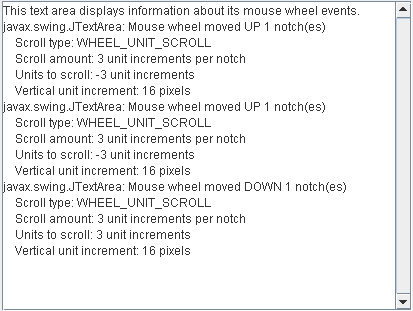How to Write a Mouse-Wheel Listener
Alternatively, use the corresponding
MouseAdapter AWT class, which implements the MouseWheelListener interface, to create a MouseWheelEvent and override the methods for the specific events.
Usually it is not necessary to implement a mouse-wheel listener because the mouse wheel is used primarily for scrolling. Scroll panes automatically register mouse-wheel listeners that react to the mouse wheel appropriately.
However, to create a custom component to be used inside a scroll pane you may need to customize its scrolling behavior — specifically you might need to set the unit and block increments. For a text area, for example, scrolling one unit means scrolling by one line of text. A block increment typically scrolls an entire "page", or the size of the viewport. For more information, see Implementing a Scrolling-Savvy Client in the How to Use Scroll Panes page.
To generate mouse-wheel events, the
cursor must be over the component registered to
listen for mouse-wheel events. The type of scrolling that occurs,
either WHEEL_UNIT_SCROLL or
WHEEL_BLOCK_SCROLL,
is platform dependent. The amount that the mouse wheel scrolls
is also platform dependent. Both the type and amount of scrolling
can be set via the mouse control panel for the platform.
The following example demonstrates mouse-wheel events.

Try this:
- Click the Launch button
to run MouseWheelEventDemo using
Java™ Web Start
(download JDK 6).
Alternatively, to compile and run the example yourself,
consult the
example index.

- Move the cursor over the text area.
- Rotate the mouse wheel away from you. You will see one or more mouse-wheel events in the up direction.
- Rotate the mouse wheel in the opposite direction. You will see mouse-wheel events in the down direction.
- Try changing your mouse wheel's scrolling behavior your system's mouse control panel to see how the output changes. You should not need to restart the demo to see the changes take effect.
The output from MouseWheelEventDemo for a system that uses unit increments for its mouse wheel might look as follows:
javax.swing.JTextArea: Mouse wheel moved UP 1 notch(es)
Scroll type: WHEEL_UNIT_SCROLL
Scroll amount: 3 unit increments per notch
Units to scroll: -3 unit increments
Vertical unit increment: 16 pixels
getScrollAmount method,
indicates how many units will be scrolled and always presents a positive
number. The units to scroll, returned by the getUnitsToScroll method,
are positive when scrolling down and negative when scrolling up.
The number of pixels for the vertical unit is obtained from the
vertical scroll bar using the getUnitIncrement method.
In the preceding example, rolling the mouse wheel one notch upward
should result in the text area scrolling upward 48 pixels (3x16).
For a system that uses block increments for mouse-wheel scrolling, for the same movement of the mouse wheel the output might look as follows:
javax.swing.JTextArea: Mouse wheel moved UP 1 notch(es)
Scroll type: WHEEL_BLOCK_SCROLL
Vertical block increment: 307 pixels
getBlockIncrement method.
In this case, rolling the mouse wheel upward one notch means
that the text area should scroll upward 307 pixels.
Find the demo's code in the
MouseWheelEventDemo.java file. The following code snippet is related to the mouse-wheel event
handling:
public class MouseWheelEventDemo ... implements MouseWheelListener ... {
public MouseWheelEventDemo() {
//where initialization occurs:
//Register for mouse-wheel events on the text area.
textArea.addMouseWheelListener(this);
...
}
public void mouseWheelMoved(MouseWheelEvent e) {
String message;
int notches = e.getWheelRotation();
if (notches < 0) {
message = "Mouse wheel moved UP "
+ -notches + " notch(es)" + newline;
} else {
message = "Mouse wheel moved DOWN "
+ notches + " notch(es)" + newline;
}
if (e.getScrollType() == MouseWheelEvent.WHEEL_UNIT_SCROLL) {
message += " Scroll type: WHEEL_UNIT_SCROLL" + newline;
message += " Scroll amount: " + e.getScrollAmount()
+ " unit increments per notch" + newline;
message += " Units to scroll: " + e.getUnitsToScroll()
+ " unit increments" + newline;
message += " Vertical unit increment: "
+ scrollPane.getVerticalScrollBar().getUnitIncrement(1)
+ " pixels" + newline;
} else { //scroll type == MouseWheelEvent.WHEEL_BLOCK_SCROLL
message += " Scroll type: WHEEL_BLOCK_SCROLL" + newline;
message += " Vertical block increment: "
+ scrollPane.getVerticalScrollBar().getBlockIncrement(1)
+ " pixels" + newline;
}
saySomething(message, e);
}
...
}
The Mouse Wheel Listener API
The MouseWheelListener Interface
Although MouseWheelListener has only one method,
it has the corresponding adapter class — MouseAdapter.
This capability enables an application to have only one adapter class instance for the component to manage all types of events from the mouse pointer.
| Method | Purpose |
|---|---|
| mouseWheelMoved(MouseWheelEvent) | Called when the mouse wheel is rotated. |
| Method | Purpose |
|---|---|
| int getScrollType() | Returns the type of scrolling to be used. Possible values
are WHEEL_BLOCK_SCROLL and
WHEEL_UNIT_SCROLL, and are determined by the
native platform.
|
| int getWheelRotation() | Returns the number of notches the mouse wheel was rotated. If the mouse wheel rotated towards the user (down) the value is positive. If the mouse wheel rotated away from the user (up) the value is negative. |
| int getScrollAmount() | Returns the number of units that should be scrolled per notch.
This is always a positive number and is only
valid if the scroll type is
MouseWheelEvent.WHEEL_UNIT_SCROLL.
|
| int getUnitsToScroll() | Returns the positive or negative units to scroll for the
current event. This is only valid when the scroll type is
MouseWheelEvent.WHEEL_UNIT_SCROLL.
|
Examples That Use Mouse Wheel Listeners
The following table lists the examples that use mouse-wheel listeners.
| Example | Where Described | Notes |
|---|---|---|
MouseWheelEventDemo
|
This section | Reports all mouse wheel events that occur within a text area to demonstrate the circumstances under which mouse wheel events are fired. |
